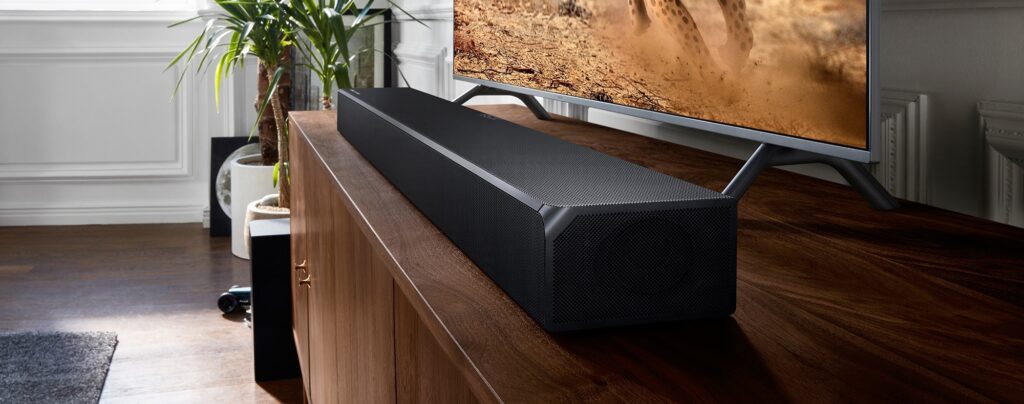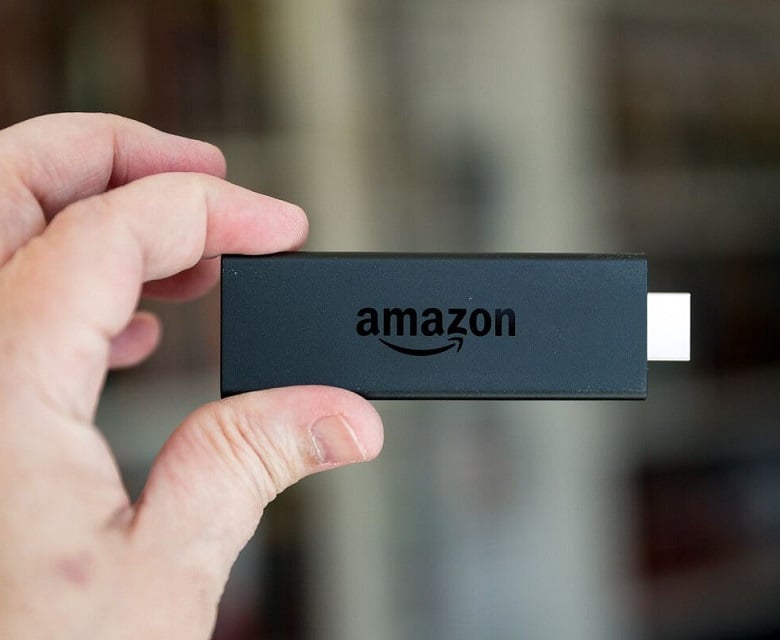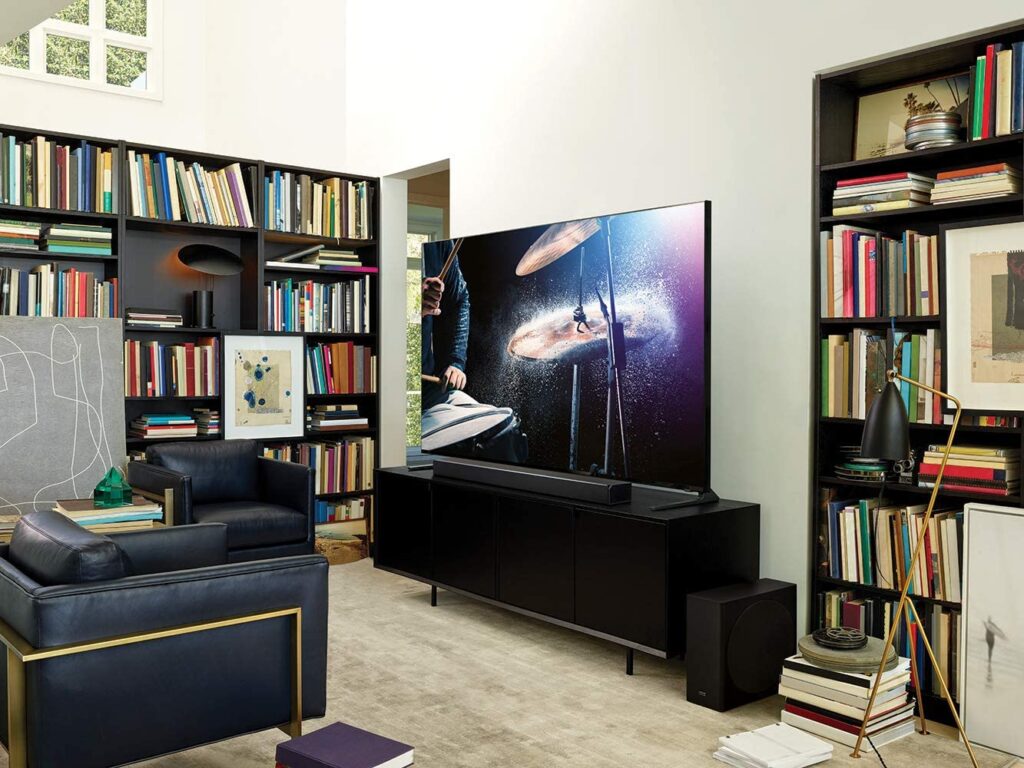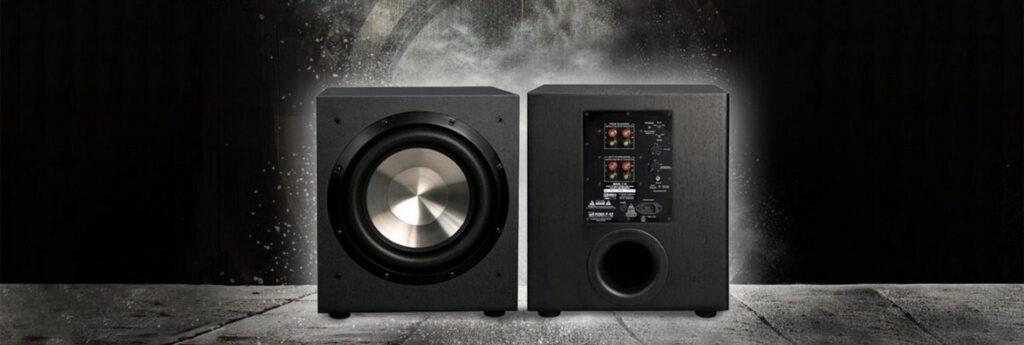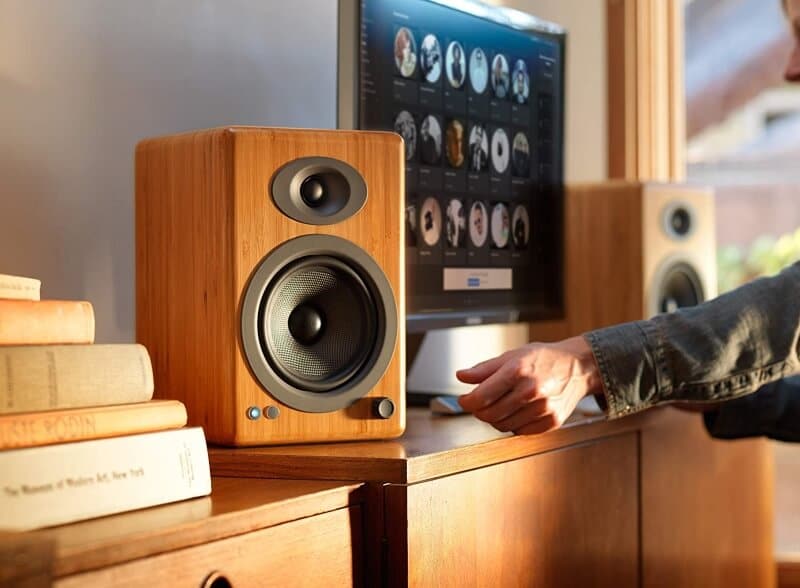Getting a high-quality audio experience used to require buying large, expensive floor-standing speakers. But with today’s audio technology, you can get similar sound quality from a much more compact set of bookshelf speakers. This is especially helpful if you’re home is limited in space, or you want to keep to a strict budget.
To help you find the best bookshelf speakers under $300, we considered a number of different factors. For example, we looked at output power, which affects how loud your speakers can be without suffering distortion. We also looked at the overall sound quality and special features that can help a set of speakers pump out the bass or match any sound. With all that in mind, let’s take a closer look at the top 5 bookshelf speakers under $300. Especially considering the Sony SSCS5, which is our best of the best pick.
More features: high-resolution audio; bass reflex enclosure; 3-way, 3-driver speaker system
This inexpensive set of bookshelf speakers from Sony offers impeccable audio quality. The speakers have a 3-way, 3-driver construction and feature an enlarged 5.12-inch MCR woofer unit. Together, these factors allow it to pump out bass with more clarify than almost any other speaker set we reviewed.
On top of that, Sony put a lot of thought into the quality of the tweeter unit on these speakers. The 0.98-inch main tweeter features a soft dome made with polyester fiber, which reproduces mid- and high-frequency sounds faithfully. There’s also a super tweeter with its own 0.75-inch dome to help capture high-frequency sounds with high accuracy. Users noted that vocals sounded especially good on these speakers.
The speaker cabinet is made completely from wood and strengthened to help prevent unwanted vibrations. That not only helps sound resonate from these speakers, but also ensures they’ll last for years to come.
What we liked: These speakers have a sensitivity of 87 dB, which is very good for a speaker set at this price point. That means you get nearly all of the 100 watts of available power and get high-quality audio even with the volume turned all the way up.
What could be better: These speakers are slightly large for bookshelf speakers, which is ultimately necessary to fit a 5.12-inch woofer unit. However, if you’re tight on space, you might find these bookshelf speakers to be slightly too big for your home.
More features: Bluetooth pairing capability; DSP and DRC support for minimized distortion; dual RCA input; wireless remote
If you’re looking for a set of Bluetooth speakers for under $300, we recommend the Edifier R1700BT. This powered Bluetooth bookshelf speaker set can connect to any mobile device, computer, or smart TV wirelessly, or connect to your devices or an audio receiver using RCA cables to be used as part of a home theater system. The speakers also come with a wireless remote, so you can control your audio from anywhere in your home.
This speaker set is small, boasting just 66 watts of power and a four-inch bass unit. But don’t let that fool you. Users found that these speakers are capable of producing a surprising amount of sound thanks to the resonant wooden cabinet. The speakers also support digital signals processing, which helps to reduce distortion on either end of the frequency range.
What we liked: One of the things users liked best about this speaker set is that it is highly flexible. You can adjust the treble and bass independently, using simple control knobs to lift or depress the levels between -6 and +6 dB.
What could be better: These speakers aren’t as sensitive as some competitors we reviewed. They have a rated sensitivity of just 85 dB. Combined with the relatively low power rating, this means that you can get a far amount of distortion when turning the volume all the way up.
More features: dual RCA input; remote control
This versatile speaker set from Edifier trades power for sound quality. The speakers have just 42 watts of power, so these aren’t the speakers you should choose if you plan to crank up the volume.
However, if you can live with a slightly muffled sound, the audio fidelity is excellent. Users found that the bass on these speakers is deep and punchy despite the bass unit being just four inches in diameter. The tweeter unit is also small – just 0.47 inches – but it produces clear high-frequency notes that don’t sound as airy as some other speakers.
Even better, you have control over the speakers’ sound reproduction. The bass and treble are fully controllable from -6 to +6 dB using control knobs on the side of the main speaker. You can also control the sound and volume from across the room using the included remote control.
What we liked: These active bookshelf speakers under $300 are great for first-time users since they don’t require a receiver to use. The speakers also come with dual RCA inputs, so you can keep your speakers connected to a surround sound system while also plugging in a computer or phone to play music. The speakers are pre-connected with speaker wire and Edifier provides all the cables you need to set up your sound system.
What could be better: The lack of power is a major drawback to these speakers. At 42 watts, they don’t get very loud before you start running into distortion. As a result, these speakers are best suited for very small rooms or as rear speakers in a surround sound setup.
More features: 90 x 90 square tractrix horns; bass-reflex via rear-firing port
The R-41M bookshelf speakers from Klipsch are surprisingly powerful for their size. They feature 200 watts of output power, roughly double any of the other comparable speakers we reviewed. Better yet, the speakers take advantage of all that power. They have a sensitivity of 90 dB, the best rating of any bookshelf speaker we looked at.
The woofer unit is only four inches in diameter, but it’s reinforced with spun copper to provide a deeper sound that resists rumbling. The tweeter unit is also quite large, at one inch around, and is mated to a 90 x 90 square Tractrix Horn. The horn, a proprietary Klipsch design, ensures that high-frequency sound is directly aimed at the listener and reduces artificial reverb from the speaker assembly.
What we liked: For a budget-friendly pair of speakers, the R-41M speakers look extremely stylish. They feature low-profile magnetic grilles and exposed fasteners that give them a modern appearance. Plus, the case is finished with scratch-resistant wood for durability.
What could be better: One important thing to keep in mind is that these speakers are passive. That means that they must be connected to an amplifier or a powered speaker to work. So, the ultimate price can be significantly higher than the price for the speakers alone.
More features: wall-mountable; compatible with most home theater AV receivers
The T15 speakers from Polk Audio are among the best budget bookshelf speakers on the market today. This pair of speakers costs under $70 and offers many of the same specs as our Editor’s Choice speakers from Sony. You get 100 watts of power, a 5.25-inch bass unit, and a 0.75-inch tweeter unit. These speakers might not have a dedicated mid-range unit, but they provide excellent audio fidelity at a price that any audiophile can afford.
These speakers are especially useful if you’re building a home surround sound system. They can be used as front, rear, or surround speakers and are compatible with almost any audio receiver. Polk’s Dynamic Power technology enhances low-frequency sound quality, which is good for watching movies.
What we liked: These speakers are extremely compact and lightweight, making them perfect for almost any space in your home. They’re also able to be mounted on the wall, so you don’t even need a shelf to raise them to the proper height for optimal listening.
What could be better: On the high end of the frequency spectrum, though, the T15 speakers can sound sharp and tinny. Most users won’t notice this if the speakers are used primarily for television and movies. But if you’re playing music from these speakers, the sharp sound can be much more noticeable.
Now that you know more about the five best bookshelf speakers under $300, how do you decide which set is right for your needs? In our buying guide, we’ll cover everything you should know about choosing speakers – from what $300 can buy you to what features to look for.
You might be surprised at just how much audio quality you can get for under $300. Although these bookshelf speakers come at a budget price, they often use much of the same hardware as more expensive speakers. Plus, competition in the low-cost bookshelf speaker market is fierce. So, manufacturers have a lot of incentive to pack their speakers with features without raising prices.
The biggest difference between bookshelf speakers under $300 and more expensive models is in output power. Generally, cheap bookshelf speakers come with 200 watts of power or less. If you have a massive room to fill, spending more money for more powerful speakers might be necessary. But most people are using bookshelf speakers in smaller rooms where power isn’t a major concern anyway.
There are dozens of bookshelf speakers priced under $300, but not all speakers in this price range are made equally. Before you settle on a set of speakers, make sure you know what features to look for and how they can affect your sound quality. Here, we’ll cover all the key features you should know.
One key difference you should know about when considering bookshelf speakers is that there are two different types. Two-way speakers have just a woofer and a tweeter, while three-way speakers have a woofer, a tweeter, and a mid-range unit.
Three-way speakers offer somewhat better sound quality, since that extra unit allows the speaker to get the mid-tones of your audio just right.
However, three-way speakers also tend to be much more expensive than their two-way counterparts. As a result, there aren’t many high-quality three-way bookshelf speakers under $300. Our Editor’s Choice, the Sony SSCS5 speaker set, is one of the few three-way bookshelf speaker sets that sneaks under this price point without sacrificing quality elsewhere.
After speaker type, power is one of the most important things you want to consider. The higher your speakers’ power, the greater volume they’ll be able to sustain without distorting your sound quality. If you need to fill a large room or your whole house with sound, more power is critical.
Bookshelf speakers are by definition compact, so they tend to be light on power – especially if you’re on a budget. 100 watts, which you’ll find on the Sony and Polk Audio speaker sets, is generally enough for most medium-sized rooms. If you want to crank the volume, you can find speakers up to 200 watts like the Klipsch R-41M speakers.
The bass unit on your bookshelf speakers will determine whether a bass line comes out clearly or just as a muddled rumble. The main factor to look for is the size of the woofer itself. A four-inch woofer is standard on bookshelf speakers, since this size does a nice job of balancing bass and compactness. However, on larger bookshelf speakers like the Sony and Polk Audio speakers, you’ll find woofers that are over five inches in diameter.
The tweeter unit controls the high-frequency sound output from your speakers. Once again, the diameter of the unit is the main factor that differs among speakers. A 0.75-inch diameter is most common, but some speakers like the Edifier R1280T speakers have a smaller tweeter unit that can handle very high frequency sounds without tinniness. Also look for soft speaker domes, which help to smooth the output coming from the tweeter unit.
The overall frequency range of a speaker set describes the total range, from bass to treble, that it can produce without distortion. In theory, a wider frequency range is better.
But in reality, it’s hard to compare frequency ranges from one brand to another – or even between speakers from the same brand. That’s because the volume of sounds produced at different frequencies can vary widely. So, don’t worry too much about frequency ranges when choosing a set of bookshelf speakers.
Speaker sensitivity is a measure of how well a speaker converts power into sound. Although a speaker might boast 100 watts of power, that doesn’t necessarily mean it can turn 100% of that power into sound.
Generally, speakers with a sensitivity of at least 88 dB are considered good enough for most audiophiles. High-end speakers may have a sensitivity of 92 dB or more.
Impedance is another factor that can impact the sound quality of your bookshelf speakers. The lower your speakers’ impedance, the more easily an electrical signal passes through the wiring and components. That electrical signal is essentially sound – so a lower impedance means better sound quality, all other things being equal.
Before you buy a set of speakers, it’s important to consider how you plan to play music and other audio through them. If your devices use Bluetooth, for example, you may want to look for Bluetooth-enabled bookshelf speakers like the Edifier R1700BT speakers.
If you’ve already picked out an audio receiver, make sure that your speakers will be compatible with it.
Bookshelf speakers are generally best for situations in which you don’t have room for a larger set of floor speakers. So, size often matters a lot. Larger speakers like the Klipsch speaker set may offer more power, but of course you need more room to house them. Compact bookshelf speakers give up some power and may have a smaller woofer unit.
Most manufacturers provide a warranty for their speakers. This is important – even if you’re spending under $300, you want to be sure that you’re covered in case you get a defective set of speakers. Warranty terms range from just two years to as many as five years (in the case of the Klipsch speakers), so make sure to check what your manufacturer offers.
Some bookshelf speakers come with extra features to give you a more seamless audio experience. The most common extra is a wireless controller, which you can use to adjust the volume and tone of your speakers without going through your audio receiver. Some speakers, like the Sony and Klipsch speakers, also have extra features around the woofer unit to offer a more resounding bass sound.
All of the speakers we reviewed are under $150, and even at that price point you don’t give up much in terms of quality. However, if you’re on a very tight budget, you can find quality bookshelf speakers like the Polk Audio speakers for less than $70.
Our three overall favorite bookshelf speakers under $300 are the Sony SSCS5, the Edifier R1700BT, and the Edifier R1280T speakers. The Edifier R1280T speakers are light on power, but they deliver magnificent audio quality that’s hard to beat. The bass is deep and punchy, while high-frequency audio is clear and crisp. The Edifier 1700BT bookshelf speakers offer significantly more power as well as Bluetooth compatibility. That’s a huge plus for ease of use since you can instantly play music or videos from your phone or computer through these speakers without a receiver. The audio quality is quite good, and you have control over the bass and treble levels. We think the Sony SSCS5 speakers are the overall best bookshelf speakers under $300. They pack 100 watts of power and have a three-driver design that ensures faithful sound reproduction in the mid-frequency range. Plus, the all-wood cabinet ensures you get a resonant sound with little unwanted vibration.
